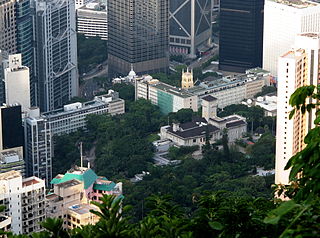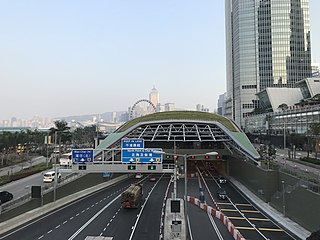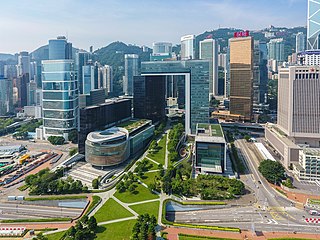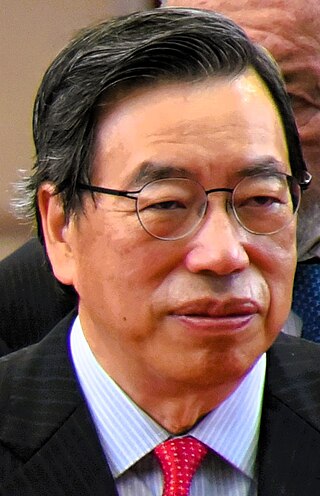
The Legislative Council of the Hong Kong Special Administrative Region (LegCo) is the unicameral legislature of Hong Kong. It sits under China's "one country, two systems" constitutional arrangement, and is the power centre of Hong Kong's hybrid representative democracy, though popular representation in the legislature has diminished significantly in recent years, along with its political diversity.

Hong Kong City Hall is a building located at Edinburgh Place, Central, Hong Kong Island, Hong Kong.

The West Kowloon Cultural District is a large arts development in Hong Kong. Designed and planned by Foster and Partners, the district comprises 40 hectares with 17 venues. Major establishments include Xiqu Centre for Chinese opera, the Freespace Centre for contemporary performance, the M+ Museum, and the Hong Kong Palace Museum. As of 2023, the Lyric Theatre and other commercial structures are under construction. It is managed by the West Kowloon Cultural District Authority (WKCDA).

Edinburgh Place is a public square in Central, Hong Kong, adjacent to the Victoria Harbour. The Hong Kong City Hall is located in the square. In addition, the Edinburgh Place Ferry Pier and Queen's Pier were also located in the square before they were demolished in early 2007.

The Former Central Government Offices, now called Justice Place, is an office building complex that formerly housed most of the major offices of the Hong Kong Government. The complex is located in Central, Hong Kong, occupying the lower level of Government Hill. The offices of the government have been relocated to the Main Block of the Central Government Complex, Tamar.

Tamar is the administrative centre of Hong Kong located in Admiralty. The headquarters of Hong Kong's Legislative Council and Central Government are located in Tamar. Adjacent to the island's financial heart at the Central harbourfront, the word Tamar is often used as a metonymy for the Government of Hong Kong.

Leung Yiu-chung is a Hong Kong politician. He is a member of the pro-labour Neighbourhood and Worker's Service Centre, which is a part of the pan-democracy camp. He has had a long-standing tenure as a member of the Legislative Council of Hong Kong. Between 1998 and 2016, he represented the New Territories West geographical constituency, and from 2016 to 2020, he represented the District Council (Second) functional constituency. Leung has also served as a member of the Kwai Tsing District Council since 1985.

The Hong Kong Science and Technology Parks Corporation (HKSTP) is a public corporation set up by the Hong Kong Government in 2001 to foster innovation and technology development in Hong Kong.

Central and Wan Chai Reclamation is a project launched by the government of Hong Kong since the 1990s to reclaim land for different purposes. This includes transportation improvements such as the Hong Kong MTR station, Airport Express Railway & Central-Wan Chai Bypass, as well as public recreation space such as the Central Harbourfront Event Space, Tamar Park and the Hong Kong Observation Wheel.

The Central–Wan Chai Bypass is a 4-kilometre (2.5 mi) trunk road running between Sheung Wan and Fortress Hill on Hong Kong Island. The original design consists of a 2.3 km dual three-lane tunnel running under new reclamation areas provided by the Central and Wan Chai Reclamation project, and also connections to Connaught Road West flyover and Island Eastern Corridor. It substitutes Connaught Road Central, Harcourt Road, Gloucester Road and Victoria Park Road to be part of Route 4.

The Antiquities Advisory Board (AAB) is a statutory body of the Hong Kong Special Administrative Region with the responsibility of advising the Antiquities Authority on any matters relating to antiquities and monuments. The AAB was established in 1976 along with the Antiquities and Monuments Office (AMO) when the Antiquities and Monuments Ordinance (Cap. 53) was enacted, and comprises members appointed by the Chief Executive. The corresponding governmental ministry is the Development Bureau, and executive support for the AAB is provided by the AMO which is under the Development Bureau.

The Central Government Complex has been the headquarters of the Government of Hong Kong since 2011. Located at the Tamar site, the complex comprises the Central Government Offices, the Legislative Council Complex and the Office of the Chief Executive of Hong Kong. The complex has taken over the roles of several buildings, including the former Central Government Offices (CGO), Murray Building and the former Legislative Council Building.

Jeffrey Lam Kin-fung, GBS, JP is a non-official member of the Executive Council (Exco) and member of the Legislative Council (Legco), representing the Commercial (First) functional constituency. He is currently the vice-chairman of the pro-business pro-Beijing Business and Professionals Alliance for Hong Kong (BPA).

Andrew Leung Kwan-yuen is a Hong Kong politician who is the current President of the Legislative Council of Hong Kong (Legco), representing the Industrial (First) functional constituency. From October 2012 to October 2016, he was the chairman of Business and Professionals Alliance for Hong Kong (BPA), the second largest party in the legislature.

The anti-Hong Kong Express Rail Link movement was a social movement and period of civil discontent in Hong Kong between mid-2009 and early 2010. Select groups of Hong Kong residents protested at the proposed Hong Kong section of the Guangzhou–Shenzhen–Hong Kong Express Rail Link, a high-speed railway that would link Hong Kong with mainland China's growing high-speed rail network.

Kai Tak Sports Park is a multi-purpose sports venue that is being built at the site of the former Kai Tak Airport in Kowloon, Hong Kong. The sports park will be located on the north western part of the old Kai Tak Airport, where some of the parking stands used to be.
Tim Mei Avenue is a street in Admiralty, Hong Kong.
The Hong Kong Legislative Council members' oath-taking controversy was a series of events surrounding the oaths of office of a dozen pro-democracy and localist camp members-elect of the Legislative Council of Hong Kong (LegCo) on 12 October 2016 which have resulted in the disqualification of six members, Sixtus "Baggio" Leung and Yau Wai-ching of Youngspiration, who were unseated by the court on 15 November 2016, and Leung Kwok-hung, Nathan Law, Yiu Chung-yim and Lau Siu-lai on 14 July 2017.
The Hong Kong 2030: Planning Vision and Strategy is a study group tasked with preparing a strategic land use planning framework for Hong Kong up to year 2030. The HK2030 Study aimed to provide strategic framework for future land use in New Territories to address long-term housing demands in the New Development Areas (NDAs) of Kwu Tung North (KTN) and Fanling North (FLN). In 2008 “The North East New Development Areas Planning and Engineering Study” began; it continued until 2013.

On 1 July 2019, anti-government protesters in Hong Kong sieged, broke into, and subsequently occupied the Legislative Council Complex during the campaign to halt the enactment of the Fugitive Offenders amendment bill. Hundreds of protesters broke through the glass walls and metal doors and entered the building, then ransacked and vandalised the interior with anti-government and anti-PRC slogans. It is considered a watershed event in the 2019–2020 Hong Kong protests. Nine days later, on 9 July, the Chief Executive, Carrie Lam, announced that the extradition bill was "dead".


















